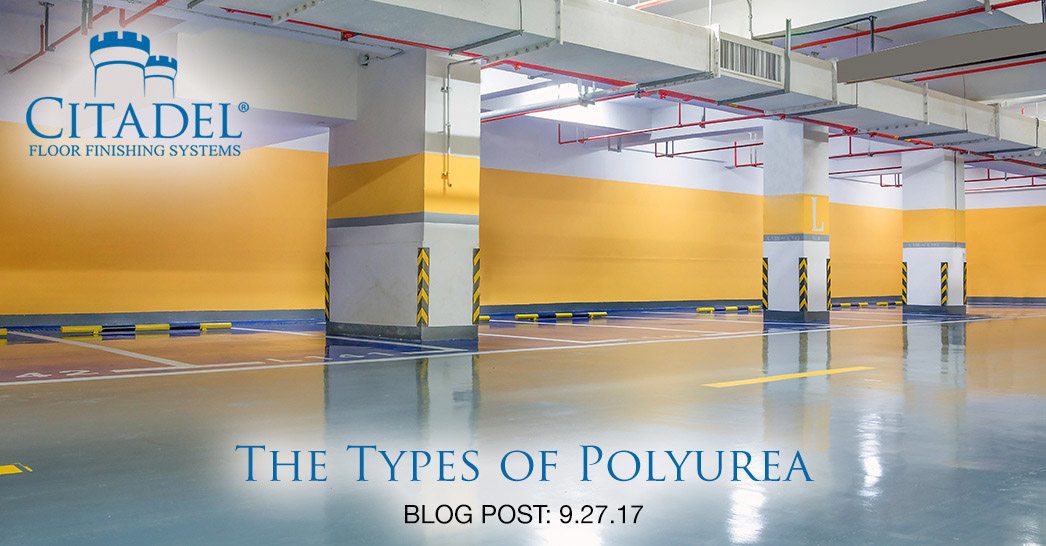For the Best Chemical Resistance and UV Protection (While Saving Installers Time and Labor), Pick Polyurea
(A glossary of terms, article 2 in the series)

2017-09-27
We are continuing our article series defining common industry terms so you make the best production selections for your customers and keep your team's knowledge cutting edge. Today's article discusses why polyurea is your best choice for chemical and UV resistance. The answer lies in the difference between "aromatic" and "aliphatic" polyureas.
Although polyurea may have a higher relative material price when compared to other coatings, the hidden cost for alternatives is in longer cure times and the need to apply more coats. Understanding the science behind the products helps you explain to customers why polyurea concrete floor coatings are the best choice for beautiful, durable floors, over cheaper, more labor-intensive options.
So, what is the difference between aromatic and aliphatic polyurea? (And why should you care?)
In a nutshell, aliphatic polyurea are your UV stable topcoats, typically used to thinly cover the aromatic polyurea applied underneath, to protect it from UV degradation.
Aromatic molecules are very stable, and do not break apart easily to react with other substances, hence the extremely high resilience and chemical resistance of polyurea floor coatings – especially helpful in industrial and commercial applications where regular exposure to chemicals is a concern.
Aliphatic compounds, also known as non-aromatic compounds, can be similarly structured to aromatic compounds, but without the especially stable ring of atoms that defines the difference between the two. In other words, if it's not aromatic, it's aliphatic.
That's great and all, but how will it help? Stay with me: the magic is in how aromatic and aliphatic polyurea work together.
"Aromatic-based polyurea systems have been the workhorse of polyurea technology," Dudley J. Primeaux II of Primeaux Associates writes in his article, Polyurea Elastomer Technology: History, Chemistry & Basic Formulating Techniques.
One of the advantages of aromatic polyurea is its ability to carry single-tint as well as complex pigments and other dispersions, giving your customer an attractive as well as durable floor. However, its ability to carry colors is also its Achilles' heel, according to Primeaux: "The main limitation of the aromatic polyurea system is overall color stability. All aromatic based polyurea elastomer systems will fade or change color when exposed to ultraviolet light."
This is where aliphatic polyurea comes in. Covering aromatic coatings with an UV stable aliphatic polyurea offers the best of both worlds, creating the most UV-stable, chemically resistant floors which can be installed indoors or out, and in the most chemically-challenging environments. "Aliphatic polyurea systems have excellent resistance to degradation by ultraviolet light and are used for a variety of exterior and interior atmospheric services," explains Primeaux.
Primeaux concludes, "Polyurea coating systems… [have] shown a good deal of versatility and application use. The rapid dry time characteristics provides for an extremely good cost and time-effective solution to a variety of coating applications over conventional technologies. With the extreme efforts for industrial rehabilitation and increasing need to comply with environmental, economic and time constraints, the speed and durability of polyurea technology hold great promise."
Indeed, polyurea technology has lived up to and exceeded that promise in the 10+ years since Primeaux's article. If you would like to learn more about how polyurea can save your team time and effort while meeting your customer's chemical resistance and UV protection needs, click here to schedule a free consultation with one of our friendly experts.
Latest News
How to Maintain Your Concrete Grinder
Gain Customers and Referrals in 4 Easy Steps
Ready for the Summer Rush? 4 Ways to Prepare
6 Cold Weather Safety Tips for Installers
How to Remove Salt Stains from Concrete
Testimonials
Every time I call I get to talk to someone, and I always have an answer within 20 minutes. That's awesome.
Client: Terry C.

